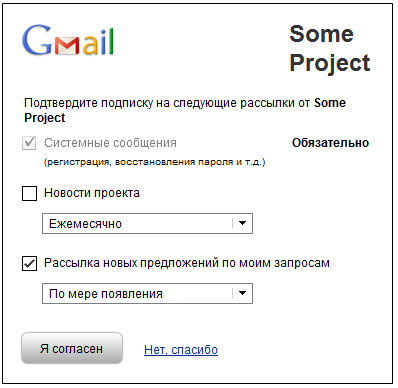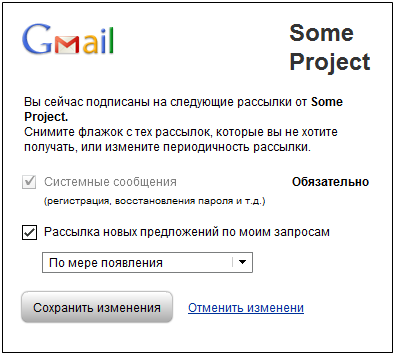Subscriptions, subscriptions and spam. Thoughts of a weary mail owner
While I was writing this topic I dropped 5 mailing lists in inbox. Three of them went into spam.
Colleagues, in my opinion, we all have long been tired of the amount of spam, subscriptions and other information that falls into our mailboxes, just because we have left our mailbox somewhere. Recently, it has gotten me so badly that I send in spam mailings that have no links to “unsubscribe”.
After thinking a bit about it, I figured out how to deal with all this.
')
Who cares please inside.
It is no secret that most email accounts are on corporate servers. Google, Yandex, Rambler, Jahu.
So they should think about what to do next. It is 2011, and mailings are still processed at the level of 1995. They will have to finish their systems slightly.
Here is what needs to be done in my opinion.
All the rest immediately send to spam. Sources of mailing can be considered the default sending more than more than 20 (50, 100, N - is discussed) letters per hour.
This measure will allow you to control the mailing server of the recipient, and for the sender to more efficiently receive information about those who actually reads it.
Those. if I enter my email somewhere and the authors of the project want to send me something from time to time, a pop-up opens, in which I indicate what I agree to subscribe to.

This will allow users to cut off unnecessary offers. And you can not throw out all the options at once, but let's say at registration confirm only the first option and the news. When I choose a subscription for some information I need, for example, new offers on a real estate website, show a popup with the third checkbox.
Now it's all done horribly. Typical cases in mailings in order of decreasing irritation:
But this gives the most precise control over what exactly you want to receive or not to receive from the site.
As a result, the ideal version seems to me that in the mail interface, next to the usual “Delete” buttons, etc., show the “Unsubscribe” button. Then popup is shown with the settings of the mailing from this site.

Thus, the owner of the list has 100% control over the statistics on the audience, and I, as a user, can control the information that falls into my inbox.
Total implementation of these three methods will significantly reduce the flow of unnecessary information in the mail.
Waiting for feedback in the comments.
Colleagues, in my opinion, we all have long been tired of the amount of spam, subscriptions and other information that falls into our mailboxes, just because we have left our mailbox somewhere. Recently, it has gotten me so badly that I send in spam mailings that have no links to “unsubscribe”.
After thinking a bit about it, I figured out how to deal with all this.
')
Who cares please inside.
It is no secret that most email accounts are on corporate servers. Google, Yandex, Rambler, Jahu.
So they should think about what to do next. It is 2011, and mailings are still processed at the level of 1995. They will have to finish their systems slightly.
Here is what needs to be done in my opinion.
1. All mailing sources must be registered on the recipient server.
All the rest immediately send to spam. Sources of mailing can be considered the default sending more than more than 20 (50, 100, N - is discussed) letters per hour.
This measure will allow you to control the mailing server of the recipient, and for the sender to more efficiently receive information about those who actually reads it.
2. Subscription to the newsletter should be monitored on the recipient server.
Those. if I enter my email somewhere and the authors of the project want to send me something from time to time, a pop-up opens, in which I indicate what I agree to subscribe to.

This will allow users to cut off unnecessary offers. And you can not throw out all the options at once, but let's say at registration confirm only the first option and the news. When I choose a subscription for some information I need, for example, new offers on a real estate website, show a popup with the third checkbox.
3. Unsubscribe.
Now it's all done horribly. Typical cases in mailings in order of decreasing irritation:
- Links to "unsubscribe" is not at all. My letter goes to spam.
- There is a link to “unsubscribe”, but it leads somewhere where you need to enter your password. In 99.99% I do not remember him. The letter goes to spam.
- There is a link to “unsubscribe”, but they tell me that they will unsubscribe me within 10 days (depending on the site). The letter goes to spam 100%. We have the Internet and not the Post of Russia - they are sledding for 100 miles my request to unsubscribe? This is a 100% user divorce.
- There is a link to “unsubscribe”, and when they switch, they tell me that they will send a letter confirming the unsubscribe. Kuban Avia, sorry, I did not wait for the promised letter from you, as a result, guess where all the correspondence now goes?
- There is a link to “unsubscribe” and they unsubscribe me from everything. Option close to the ideal.
- There is a link to “unsubscribe”, and when I click on it, they give me a form with a list of what I am subscribed to. Here, depending on the mood.
For example, in the form of a PayPal unsubscribe, checkboxes from which you want to unsubscribe should be noted, instead of leaving them on those mailings you want to receive.
As a result, I “unsubscribed” 3 times exactly. But since I need letters from him in spam, I could not send. In the case of any other service, it would be 100% in spam.
But this gives the most precise control over what exactly you want to receive or not to receive from the site.
As a result, the ideal version seems to me that in the mail interface, next to the usual “Delete” buttons, etc., show the “Unsubscribe” button. Then popup is shown with the settings of the mailing from this site.

Thus, the owner of the list has 100% control over the statistics on the audience, and I, as a user, can control the information that falls into my inbox.
Total implementation of these three methods will significantly reduce the flow of unnecessary information in the mail.
Waiting for feedback in the comments.
Source: https://habr.com/ru/post/135511/
All Articles